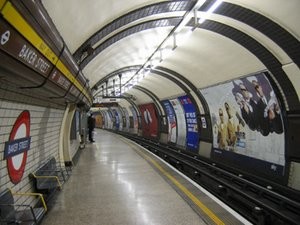 The London Underground, or the 'Tube', is a public transportation system composed of electrified railways that run underground in tunnels in central London and above ground in the city's suburbs. It is the oldest underground subway in the world, and one of the most complex, and it first went into operation in 1863. There are 275 stations and over 408 km of active lines, with three million passenger journies made each day. There are two types of subway lines: sub-surface and deep level. The sub-surface lines were dug by the 'cut-and-cover' method, with tracks about 5 metres below the surface. Trains on the sub-surface lines use the same gauge of track as regular British trains. The deep-level or 'tube' lines are about 20 metres below the surface; these tunnels are quite narrow, so the track gauge is smaller than on the sub-surface lines. Locomotives were originally steam-powered, but have now been changed to electric. During World War II, many Tube stations were used as as air-raid shelters. Following the war, steam locomotives continued to be used in the Underground until as late as 1971. Flooding is a continuing problem for the system, as the ground water in London has been rising since the 1960s. By 2001, London Underground was pumping 30,000 cubic metres of water out of its tunnels each day. |